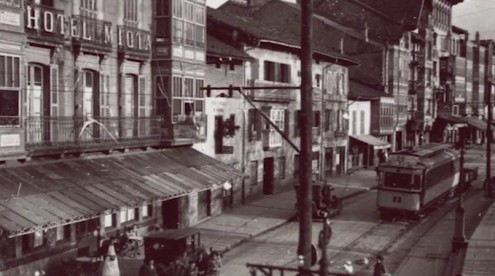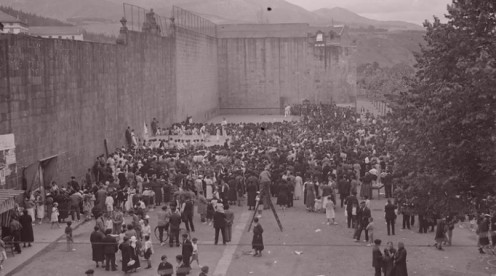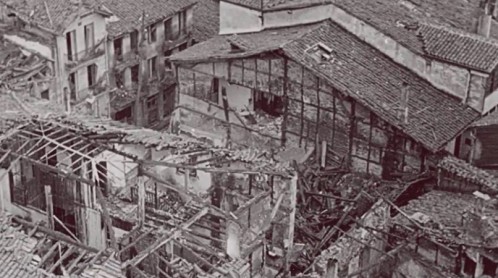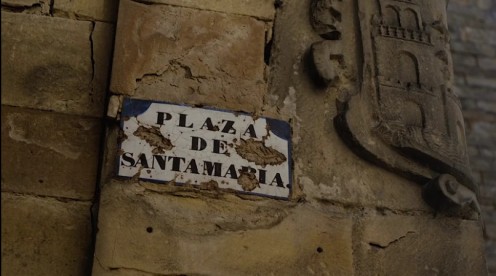
The Nationalists had tried everything to get into Madrid. Both the city and surroundings areas in all directions had already been bombarded by March 1937, eight months since the start of the SCW. Franco decided to turn his attention away from the broken yet defiant capital, and launched a new War on the North. General Emilio Mola y Vidal, who was named the leader of the north during the war while Franco commanded the south, decided to wipe out the Basque country. He already had launched offensives throughout the Basque region while basing himself in Burgos (160 kilometres south of the Basque city of Bilbao). Mola decided to deploy 50,000 troops and multiple German planes, but this time had a new plan – to launch ‘terror attacks’, where he would have his men attack civilians instead of military targets. This time, innocents were to be targeted, to inspire fear, to make the Republican held areas cower to the will of the Nationalists, or be hunted down and murdered.
The town of Durango was marked as the test target. Just 30 kilometres south of Bilbao, Durango was a small village, typical of the region and Spain as a whole. With 10,000 people, it was a rail stop between Bilbao and the front lines of the war. While it had no military operations, it was in Republican territory and ripe for attack. Mola wanted to burn the entire province of Vizcaya to the ground for being in Republican territory.



At 8.30am, inhabitants were at Mass at the Santa Maria basilica in the centre of town, and in the basilica arcade, where the local market was held. Five bombers, German Ju-52’s flown by the Condor Legion and Italian Savoia-Marchetti SM.8’s flown by the Aviazione Legionaria, set out and used the basilica as the focal point. A direct hit was scored from the very beginning; the priest and 26 worshippers were bombed to pieces. The nearby cloister was also destroyed, killed all 14 nuns inside. The market was also hit directly, killing all those looking for food, others killed by falling buildings and horrific injuries from which they could not recover. A total of 281 bombs were dropped on Durango, almost 15,000kg of explosives. Just over 200 buildings were destroyed, though some have been rebuilt and their shrapnel wounds are still visible today.



The initial bombing sent the people first into panic, followed by a desperate attempt to rescue those under rubble once the bombers disappeared again. Word spread outside the village; Bilbao received news of the bombings, and send ambulances, doctors and police to help the stricken people of Durango. The tiny village of Ellorrio, ten kilometres from Durango, with no military targets at all, and just a few thousand civilians, was also bombed, like a cruel parting shot at the region.


As help from Bilbao tried to get to Durango and people rushed around their village to save as many as they could, the worst was not over. By 5.30pm that same afternoon, the planes returned, this time accompanied by eight Heinkel He-51 fighter bombers, equipped with machine guns. Bombs were dropped to stop those from Bilbao getting to Durango, and the people of the town were machine-gunned down as they tried to help the injured and those trapped in rubble. By the end of the day 250 were dead, with another 100 to die of their injuries, and 200 homes reduced to rubble.




Killings and executions were common by now in Spain; Durango itself had previously carried out executions on Nationalist sympathisers for earlier bombings of Republicans in their small town. Between this ugliness and the front line deaths, Spain was growing used to fear. But now Mola had ushered in a whole new era. Durango became the first place in Europe to be targeted to kill civilians and not military targets. A whole new world of death was born that day in Durango.
Nationalists denied their role entirely. Mola, and Franco henchman General Gonzalo Queipo de Llano said that the Republicans attacked and killed the priest, nuns and the churches of the village, as had happened in other places. They claimed their planes were looking for military targets and it was Cocialists and Communists who came out and used the opportunity to murder innocents.
By April 28, Nationalists soldier had entered Durango and taken over the area. By then, Mola and his killers had stepped up their missions and bombed Guernica (which needs a long post on its own on its commemoration date).
Where the bombs hit in the centre of the Durango old town is now a site for historical memory, and commemorated every 31 March.

~~
This is not a detailed analysis, just a highlight (lowlight?) of events. Things get lost in translation – Feel free to suggest an addition/clarification/correction below. The more the world remembers, the better. All photos are screencaps of the video and linked to source for credit.
